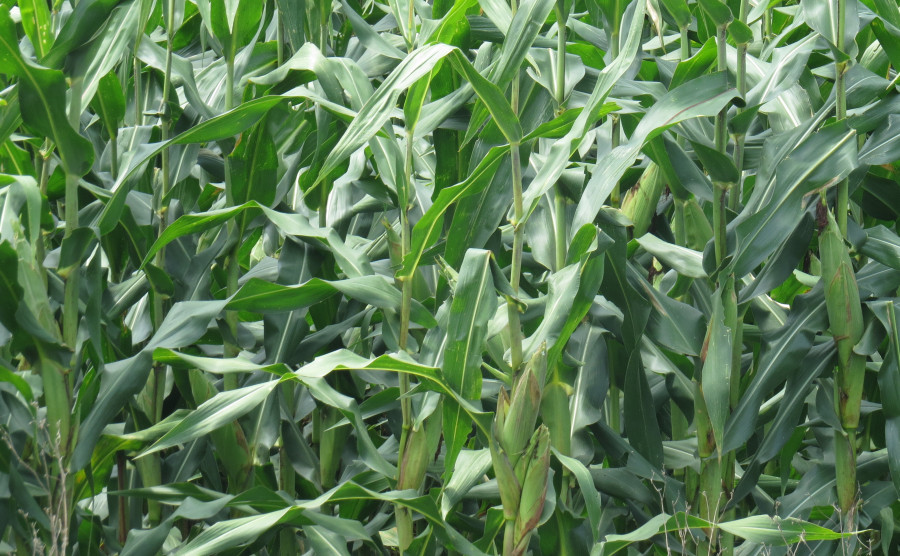Money
Nepal launches domestically developed hybrid maize variety
Farmers plant corn on 954,000 hectares, most of them using imported seeds.
Ramesh Kumar Paudel
After three years in multilocation trials, Nepal's second domestically developed hybrid maize variety has been launched for commercial production.
According to the National Maize Research Programme, Rampur, the new high yielding heat stress resilient Rampur-10 hybrid was registered in 2017, and commercial production started this year.
Narayan Dawadi, a farmer from Dibyanagar, Bharatpur, had planted Nepali hybrid maize and Indian hybrid varieties on his 8-kattha farm to compare the results.
"Initially, we were doubtful about the new variety. The productivity of Rampur-10 was equal to that of Indian hybrids which most Nepali farmers plant in their fields," he said. "The roasted maize also had a sweet taste.”
In Nepal, the reasons for low maize yield are high temperature, drought, stalk rot infestation, high input rates and use of low quality and substandard seeds.
Heat and drought stress have emerged as a common problem which can reduce maize crop productivity. Heat stress in the flowering and grain filling periods due to elevated temperatures drastically affect crop productivity.
The National Maize Research Programme first developed a hybrid variety of maize called Gaurab in 2003. But its commercial production could not flourish.
According to Keshab Babu Koirala, chief of the National Maize Crop Research Programme, maize is cultivated on 954,000 hectares across the country, and a majority of farmers plant hybrid seeds imported from India.
Nepal's average maize yield is 2.67 tonnes per hectare, one of the lowest in South Asia. The productivity of Rampur-10 is 7 tonnes per hectare in irrigated conditions, Dawadi said.
This new variety has been recommended for the Tarai and Inner Tarai or up to 700 metres above sea level.
Mitra Raj Dawadi, former president of the Seed Entrepreneurs' Association, said that the country imported 2,000 tonnes of hybrid maize seeds annually.
According to different research journals, proliferating feed factories had encouraged farmers to grow maize commercially. But still, a large amount of maize is imported from India to meet the demand of the feed industry as the local maize variety has low productivity.
According to the journal Maize Research and Development 2015, published by the Ministry of Agriculture and Livestock Development, the poultry industry needs about 664,000 tonnes of feed annually. Maize is a major raw material for the production of poultry feed.
Maize demand is increasing at a rate of 11 percent annually in Nepal. To fulfil growing demand for milk, meat and meat products, the country imports about 45 percent of its requirement of maize from India, the journal said.
Maize is a traditional crop grown for food, feed and fodder. According to the journal, the per capita maize consumption in Nepal is 98 gm per day. At this rate, the total maize requirement for food per year works out to around 2.9 million tonnes. The deficit is met by imports.
Dawadi Agrovet in Bharatpur has started selling the new seeds. Mitra Raj Dawadi, who is also a member of the National Seed Committee, will be supplying 650 kg of seeds in the market soon.
"This is the first time that production of Nepali hybrid maize seeds has started in a commercial way," said Dawadi.
Koirala said that other companies like Maharani Joda Agricultural Cooperative, Gorkha Seeds, Lumbini Seeds, Unique Seeds and Panchashakti Seeds of Jhapa have also started commercial production of Rampur-10.
"It's a good sign that Nepali firms have started producing seeds. This will help Nepal to be self-sufficient in its own hybrid variety, ” he said.
Nepali farmers have been facing problems time after time due to substandard imported seeds. In 2014, the government had to distribute relief valued at Rs230 million due to the failure of imported hybrid seeds in 2014.
"Now such problems will not occur as Nepali hybrid seed is heat stress resilient," said Koirala. Rampur has also developed a hybrid Khumaltar-2 suitable for hilly areas.




 14.12°C Kathmandu
14.12°C Kathmandu1.jpg)













%20(1).jpg&w=300&height=200)
